3.
MALAYSIA
Foreign workers have a vital role in
manufacturing
The Malaysian government has announced that as of
March this year it will lower the levies on companies
utilising foreign workers if the workers have been
employed for more than 10 years. The lowering of levies
will apply to five sectors – manufacturing, services,
construction, agriculture and plantations.
For the manufacturing, services and construction sectors
the levy will be lowered from RM10,000 to RM6,000
while that for the agriculture and plantation sectors it will
be reduced from RM3,500 to RM2,000.
Previously, foreign workers were only allowed to work in
the country for a maximum of 10 years but this has been
extended. The change has been introduced in recognition
of the difficulty in securing workers in the sectors defined.
Capacity of Penang Port to be expanded
Penang Port has allocated RM500 million for expansion of
the northern container terminal. The expansion work will
take around five years and is aimed at upgrading the
terminal status from a feeder port to a major port that can
accommodate large-sized vessels.
On completion of the upgrading the port’s handling
capacity will increase to 7.40 million (TEUs) from the
current 1.60 million TEUs. The Port of Penang was the
third busiest harbour in Malaysia in terms of cargo in
2017, handling 1.52 million TEUs of cargo.
SMEs to get support for machinery purchases
Malaysian Timber Council (MTC) is expanding its
assistance to SMEs by introducing the ‘MTC’s Financial
Incentive Programme’ for the purchase of machinery. This
programme is to encourage local timber manufacturers in
Peninsular Malaysia, particularly small and medium
enterprises, to adopt the latest mechanisation/automation
technologies.
The support includes partial reimbursement of the machine
price and freight charges for the purchase of machinery
every three years.
Eligibility specifies the company must fall within the
definition of small and medium enterprises (SME) under
the National SME Development Council’s definition and
be a member of any one of the six Malaysian timber
associations.
See: http://www.mtc.com.my/images/cms/MTC_FIPM_2019_-
guidelines___application_form-_copy.pdf
Plywood traders based in Sarawak reported the following
export prices for mid-January 2019:

4.
INDONESIA
More exhibitions means more
exposure for exporters
Endro Wardoyo, Chairman of the Association of
Indonesian Furniture and Craft Industries (Asmindo) has
called on the government to invest more in helping the
furniture and handicraft sectors promote exports. He called
for support for more trade exhibitions in Indonesia and for
assistance to exporters to attend overseas events.
Exhibitions, he said, provide an opportunity for sellers and
buyers to engage directly.
In related news the Ministry of Industry plans to study the
best way for SMEs to penetrate the US and EU markets.
Gati Wibawaningsih, Director General for Small, Medium,
and Multifarious Industries in the Ministry noted that
Indonesian craft products have a good reputation in both
the US and EU markets and efforts will be made to expand
penetration of these two markets. Gati reported that at
present only around 300 out of a total 27,000 SMEs in the
country were engaged in exporting.
Rattan and log export plan on hold for review
The Ministry of Trade recently announced that it has
frozen its decision to allow the export of raw rattan and
plantation logs, mainly because of concern raised by
furniture entrepreneurs.
Abdul Sobur, Secretary General of the Association of
Indonesian Furniture and Handicraft Industry (HIMKI)
said relaxing the rattan and log export restrictions could
undermine the competiveness of domestic furniture
manufacturers as such a move would inevitably result in a
rise in raw material costs.
Both rattan and logs were initially included in the list of
commodities for which surveyor reports (LS) for export
were no longer required.
The Minister of Industry, Airlangga Hartarto, has openly
disapproved of the plan saying these raw materials should
be processed locally to create jobs and added value
earnings.
Higher industrial plantation log supply this year
The Executive Director of the Association of Indonesian
Forest Concessionaires (APHI), Purwadi Soeprihanto, has
announced that log supplies from industrial plantations
totalled 37 million cubic metres last year and that the
Association members were confident that a 10% rise in
production can be achieved this year.
Increasing demand for pulp and paper products was
considered to be the main driver of higher production.
IFPF targets growth in furniture exports
According to the Head of the Indonesia Furniture
Promotion Forum (IFPF) a 10-15% rise in furniture
exports is possible this year.
He added that the trade dispute between the US and China
has created opportunities for Indonesian exporters who can
take advantage of the “Generalised System of Preference”
(GPS) policy in the US. On a cautionary note the Head of
the IFPF said that it is likely that demand for furniture in
the EU could experience a decline this year because of the
turmoil created by Brexit.
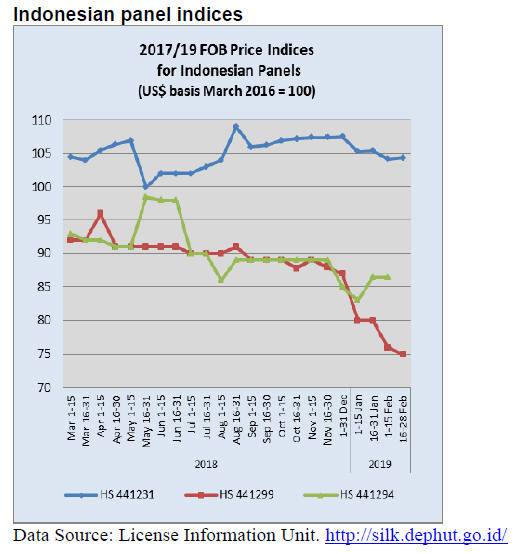
5.
MYANMAR
Uphill struggle to attract
investment
Recently the government and the Union of Myanmar
Federation of Chambers of Commerce and Industry
(UMFCCI) held an ‘Invest Myanmar Summit’ which
focused on attracting foreign investment in about 200,
mainly infrastructure, projects worth US$20 billion over
the next 20 years.
The aim of the latest investment initiative was to begin
rebuilding the image of Myanmar as an investment
opportunity after the Rakhine crisis undermined the
confidence of potential investors.
A follow up event was held in Rakhine State and was
attended by State Counsellor, Daw Aung San Suu Kyi,
who emphasised the economic potential of the State.
Participants from India, Japan, Korea, Thailand and China
attended. Analysts write the Rakhine crisis is just one of
several factors that is affecting investor confidence.
The December 2018 Business Confidence Survey from the
European Chamber of Commerce in Myanmar found that
81% of European companies were not satisfied with the
business environment, up from 76 percent in 2017.
Further, 45% said the business climate had worsened over
the previous 12 months due to regulatory issues, a
shortage of skilled labour and legal uncertainties.
See:
https://eurocham-myanmar.org/publications
MTE earnings vital to Government
Recently the Deputy Minister of Finance told an
Extractive Industries Transparency Initiative (EITI)
Workshop that the state budget has to rely on the income
of the State-Owned Enterprises, such as the Myanma
Timber Enterprise but he did not elaborate on what level
of revenue the government expects MTE to generate.
Corruption allegations in new EIA report
The latest report on the Myanmar teak trade from EIA
levels some very serious allegations of corruption against
individuals in Myanmar and appears to implicate selected
importers in Europe.
See: https://eia-international.org/
Analysts in Myanmar have been quick to point out that
most of the alleged wrong doings reported by EIA appear
to have occurred several years before the current
administration came to power in Myanmar and before the
log export and felling bans were introduced.
In an informal comment a trade analyst in Myanmar said:
“Why is the EIA digging up the past when the current
government is moving in the right direction focusing on
forest conservation. Myanmar is striving as best it can for
forest conservation and also for a legal supply chain.
These accusations of past practices associated with many
high ranking military officers could have a negative
impact on the current process of establishing a mechanism
that verifies the legality of Myanmar wood products.”
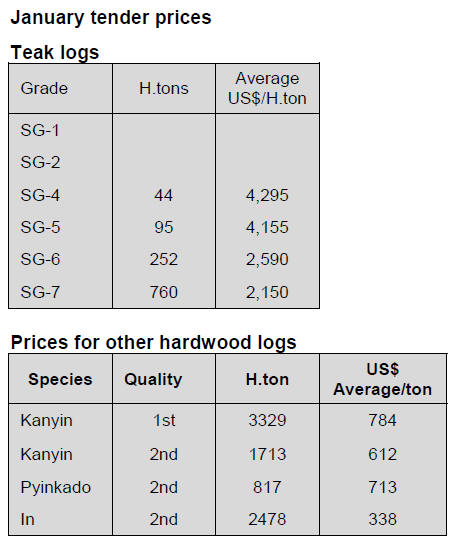
6. INDIA
Lower inflation forecast
The Reserve Bank of India, in its sixth bimonthly policy
review, revised downwards the path of inflation to 2.8% in
the fourth quarter of 2018-19, 3.2-3.4% in first-half of
2019-20 and 3.9% in the third quarter of 2019-20, with
risks broadly balanced around the central trajectory.
It also projected the inflation outlook remains soft in the
near term while flagging certain risks which merit "careful
monitoring" going forward. These include volatile retail
prices, trade tensions and geopolitical developments which
could impact commodity prices.
GST relief for real estate sector coming
At a recent CREDAI event the Indian Finance Minister
announced the government is likely to suggest that the
next GST Council Meeting consider lowering the GST for
the real estate sector. He also said state-run banks have
been asked to meet with housing developers to work out
new financing packages for building projects that have
been delayed because of financing difficulties.
The Indian real estate sector faces serious difficulties at
present because so many projects are behind schedule
because of financing problems, poor sales (buyers
consider homes over-priced) and the the Real Estate
(Regulation and Development) Act, 2016 (RERA) is not a
yet adopted across the country leading to confusion as to
which regulations apply.
The major issue, say analysts, is that a large number of
building projects have been undertaken at a time when the
home buyer market is not strong mainly because of the
high asking prices for completed homes.
In an effort to cut costs, even as new building projects
come on line, developers are moving away from teak
joinery (even plantation teak) which is traditional in Indian
homes in favour of cheaper alternatives such as kapur,
meranti and nyatoh. Some are even turning to WPC
mouldings and extrusions.
C&F prices for imported teak remain within the same
range as previously quoted.
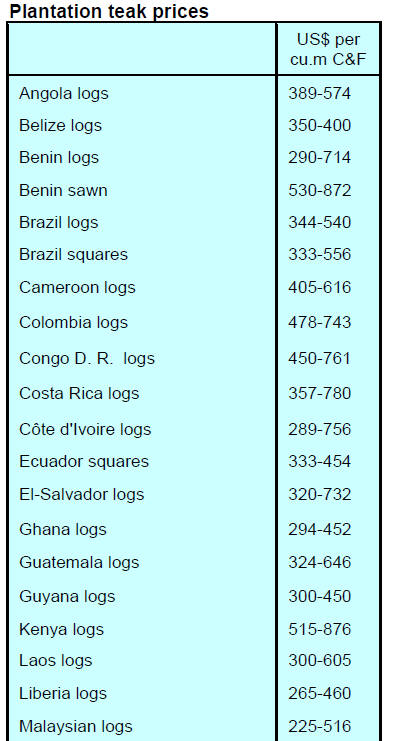
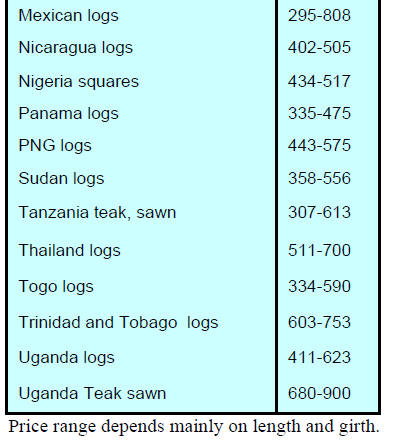
Locally sawn hardwood prices
Prices for imported hardwood sawnwood remain
unchanged from a month earlier.
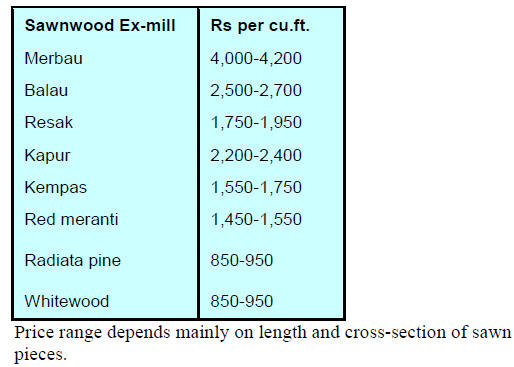
Myanmar teak prices
Indian manufacturers continue to complain over the high
costs of locally milled and imported Myanmar sawnwood.
Many sawmills are now milling lower cost large sized
plantation teak from Ghana, Sudan and Tanzania. Analysts
write this sawnwood is of a comparable quality to
Myanmar F.E.Q. grade natural teak and that this material
is finding a ready market.
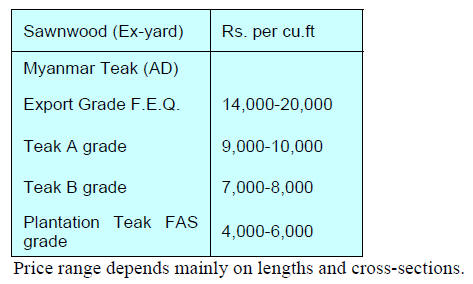
Sawn hardwood prices
Increased shipments of hardwood sawnwood from Canada
and some European member states has increased the
competion in this segment of India’s market and this is
serving to stabilise prices.
Prices for sawn hardwood imports remain unchanged.

Indian market opens to wider variety of
plywood
Plywood manufacturers are anticipating that at the upcoming
GST Committee Meeting their pleas for relief
from the punative 18% GST will garner support. While
the manufacturers are looking for a reduction of GST to
5% it seems that is very optimistic.
Birch plywood imports from Russia have found market
acceptance and are selling at a 10% premium over locally
manufactured MDF.
Analysts write that the colour bias which underpinned the
market for Gurjan faced plywood is slowly waning which
is a relef to manufacturers.
Prices for plywood continue as previously reported.


7. BRAZIL
Partnership between government
and the productive
sector
The State Secretariat of the Environment (SEMA) and the
Acre Environmental Institute (IMAC) have consolidated a
partnership with the private sector. At a recent meeting,
the State government commitment to minimise the
bureaucratic burden on the private sector in respect of
environmental legislation.
The Federation of Industries of Acre State (FIEAC) and
the Union of Forestry Companies welcomed this initiative
saying the new State/private sector relationship could raise
productivity and result in greater job opportunities.
Initially this scheme was applied to one operator but the
State Government, through SEMA and IMAC, will make
contact with other companies to extend the scheme.
Export update
In January this year the total Brazilian exports of woodbased
products (except pulp and paper) fell almost 5% in
value compared to January 2018, from US$236.8 million
to US$225.4 million.
The value of January pine sawnwood exports rose 6% year
on year (2018,US$41.3 million/ January 2019 US$43.9
million). In volume terms exports also increased by around
the same percent, from 199,300 cu.m to 211,100 cu.m.
Tropical sawnwood exports in January this year rose an
astonishing 43% in volume, from 29,000 cu.m in January
2018 to 41,500 cu.m in January 2019. In terms of value,
exports increased 31% from US$13.6 million to US$17.8
million over the same period.
In contrast the value of pine plywood exports declined in
January by almost 30% compared to a year earlier (US$54
million to US$ 38.4 million) and export volumes dropped
around 20% over the same period from 169,400 cu.m to
136,400 cu.m.
Brazil’s tropical plywood exports are now small and year
on year January 2019 exports declined in terms of both
volume and value from 12,300 cu.m (US$5.1 million) in
January 2018 to 10,600 cu.m (US$3.9 million) in January
2019.
January was not a good month for wooden furniture
exports as the value fell US$32 million in January 2018 to
US$29.8 million in January 2019, an almost 7% drop.
Brazilian furniture fair attracts global buyers
The Brazilian Furniture Project, an initiative of the
Brazilian Furniture Industry Association (ABIMÓVEL)
and the Brazilian Trade and Investment Promotion Agency
(APEX-Brazil) aims to raise the profile of Brazilian
furniture production and design. In partnership with
ABIMAD, the São Paulo trade show, international buyers
were invited to attend the mid-February fair to see the
latest trends in design in Brazil.
The fair attracted buyers from the main importers in Latin
and North America and generated around US$4 million in
immediate business.
Over the past five years it is estimated that the Brazilian
Furniture Project generated more than half a billion dollars
in business transactions. In the first eight months of 2018
the initiative generated business worth US$102 million
and for the whole of 2018 it is estimated that some
US$153 million in business transactions have been
achieved.
Analysts write, “2019 looks promising for Brazil´s
economy opening possibilities for business and
investments. Within this context the Brazilian Furniture
Project stands ready to foster business expansion”.
Furniture exports grows
Furniture exports (wooden and all others) in January 2019
increased 10.3% compared to January 2018. The total
value is US$ 42.8 million versus US$ 38.8 million in
2018; out of the 16 exporting states, 9 states presented
export level fall.
The top five exporting States are located in the South and
Southeast regions of Brazil. The State of Santa Catarina
continues to lead, with January 2019 exports coming in at
US$16.8 million, up 17% year on year, followed by the
State of Rio Grande do Sul with January 2019 exports at
US$0.9 million, a drop of 2.5% year on year.
The third ranked exporting State was Paraná with January
2019 exports worth US$6.6 million (a 17% increase). São
Paulo State is in fourth place with US$5.1 million, an
increase of 7.6% compared to January 2018. Fifth placed
is the state of Minas Gerais which posted the highest
growth in its exports, an increase of 57% compared to
January 2018.

8. PERU
SERFOR/OSINFOR alliance to
strengthen sustainable
forest and wildlife management
In order to optimise state resources, the National Forestry
and Wildlife Service (SERFOR) and the Forest Resources
and Wildlife Oversight Agency (OSINFOR) signed an
inter-institutional cooperation agreement that will allow
the exchange of experiences and information in the
supervision, control and control of the use of natural
resources.
Both agencies will strengthen their functions to improve
the efficiency and effectiveness in achieving their
institutional objectives. SERFOR and OSINFOR also
signed an agreement to align their institutional role within
the framework of the 0130 Budget Program, called
Competitiveness and Sustainable Use of Forest and
Wildlife Resources.
Legally compliant companies cannot compete in local
market
The decision of the Peruvian Government to locate
OSINFOR within the Ministry of the Environment does
not diminish its independence or its capacity to sanction
forest operations and according to the Second Vice
President of the Association of Exporters (ADEX), Erik
Fischer, the power and capacity of OSINFOR could be
enhanced through this relocation he said.
In a statement Fischer described as pure speculation the
rumours reported in some Peruvian and foreign media
about possible sanctions being imposed on Peru by the US
government because of the relocation of OSINFOR.
He stressed that legally compliant timber companies in
Peru have to rely on exports as they cannot compete in the
domestic because "it is impossible to compete with the
low prices offered by small domestic manufacturers who
utilise raw materials that cannot be traced to ensure
legality”.
Project to recover degraded forests
The World Bank's has approved the allocation of US$12.2
million to fund the Integrated Forest Management Project
to be undertaken by the Ministry of the Environment
(MINAM), in Atalaya, Ucayali the fifth most deforested
area in the country.
This initiative by MINAM will benefit more than 2,300
indigenous families and forest and seeks to restore forest
cover and introduce forest management over almost
400,000in the region.
Some of the funds will be used for small-scale cottage
business development a priority will be integrating the role
of women in implementation and management.


